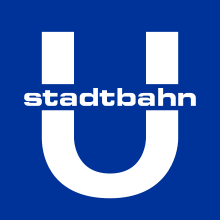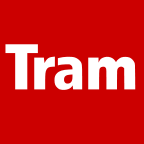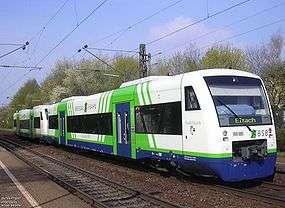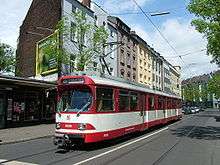Trams in Freiburg im Breisgau
|
A Landwasser-bound tram in Freiburg. | |||
| Operation | |||
|---|---|---|---|
| Locale | Freiburg im Breisgau, Baden-Württemberg, Germany | ||
| Open | 14 October 1901 | ||
| Status | Operational | ||
| Lines | 5 | ||
| Operator(s) | Freiburger Verkehrs AG | ||
| Infrastructure | |||
| Track gauge | 1,000 mm (3 ft 3 3⁄8 in) | ||
| Propulsion system(s) | Electricity | ||
| Electrification | 750 V DC | ||
| Depot(s) | 1 (Betriebshof West) | ||
| Stock | 61 trams | ||
| Statistics | |||
| Route length | 32.3 km (20.1 mi) | ||
| Stops | 73 | ||
| |||
The Freiburg im Breisgau tramway network is a network of tramways forming part of the public transport system in Freiburg im Breisgau, a city in the federal state of Baden-Württemberg, Germany.
Opened in 1901, the network has been operated since its foundation by the company now known as Freiburger Verkehrs AG (VAG Freiburg or just VAG).
History
Time before trams
After Freiburg was connected to the railway network via the Rhine Valley railway from 1845, there was an intercity transport links between the Hauptbahnhof and the Wiehre Train Station, which used the "Hell Valley Railway" for the first time in 1887. From 1891, horse-drawn buses, operated by two different private companies, transported citizens throughout the town. The horse-drawn buses were used on three lines, Lorettostraße to Rennweg, Waldsee to Hauptbahnhof and Siegesdenkmal to Bohrer and eventually were replaced by trams, except between Günterstal and Bohrer.[1]
On the 8th May, 1899, the city council made the decision to build an electric transport system in Stühlinger. Reasons for it included the University of Freiburgs increasing requirement for light and power and the planned refurbishment of the town's trams. A survey carried out in 1899 by the city council resulted in a power requirement for more than 20,000 incandescent lamps. (Quote)
The acting mayor at the time Otto Winterer decisively ensured the fast implementation of the trams. The concession for powering the tram was safeguarded by "Direktion des Elektrizitätswerkes und der Straßenbahn", the name of the former VAG company.The tasks of building electric centre for producting light and power and the tramway were assigned to the Siemens & Halske of Berlin.
Lines
As of 2014, the network had five lines all of which operated over cross-city routes:[2] The network's route length was 32.3 kilometres (20.1 mi), and its cumulative line length was 38.1 kilometres (23.7 mi).[3] Together, the five lines served 68 stops. Now there is a new tram line, line 4. The trams run from 5am to 0:30am the following morning from Monday to Friday, and at the weekend, the trams run throughout the night as well.
- On Saturdays, Sundays and Public Holidays, and from 9pm until 6:30am, Line 2's final stop from Günterstal at Siegesdenkmal.
- The trams on Lines 2 and 4 are often delayed so that there is a tram every 5 minutes.
- The Combino and Urbos trams cannot be used on Line 2 or Line 4 because the platforms at Siegesdenkmal are too small for them. Although they use trams that are double-ended, they can still be used on all other lines.
- The GT8Z is not used on Line 1 because their capacity is too small for the route.
- When SC Freiburg play at home at the Schwarzwald Stadium, additional trams are used between Bissierstraße and Littenweiler. The so-called Eilzug display a football as a symbol instead of a line number. They transport spectators from Bertoldsbrunnen and Römerhof, from where the stadium is reachable in 5 minutes, without stopping. When the game finishes, the first five trams travel non-stop until Oberlinden.
- In the evenings, from 9pm, Lines 1, 3, 4 and 5's trams meet each other in both directions at Bertholdsbrunnen on the minutes of 01, 16*, 31 and 46*. (* from 22:16, the trams only leave at 01 and 31, so that there is a tram every 30 mins.
- On the Lines 1, 3, 4 and partly the 5, from Rieselfeld to Bertholdsbrunnen, a night service is offered with trams leaving Bertholdsbrunnen every half an hour, from 1am until 4:30am) during the nights of Saturdays, Sundays and specified Public Holidays. Günterstal and other destinations are accessible by taxi or bus.
- The return journeys to and from the depot are depicted by a diagonal red slash instead of the number. A special feature in Freiburg is the reversing of the single-ended trams when they go to and from the depot. These are completed without any passengers, by using the rear driver's cab. This procedure occurs on Line 1, from VAG-Zentrum to Runzmattenweg, Line 3, Heinrich-von-Stephan-Straße to Vauban, Innsbrucker Straße and Line 5, Am Lindenwäldle to Rieselfeld, Bollerstaudenweg.
- Except for the stops at Bertoldsbrunnen, Eichstetter Straße, Klosterplatz and Oberlinden, all stations have platforms and with them it is possible to enter the tram barrier-free.
See also
References
Notes
- ↑ Peter_Kalchthaler: Wo fuhr einst Freiburgs erster Omnibus? Badische Zeitung, 6. Februar 2012, abgerufen am 13. Juni 2014.
- ↑ Peter_Kalchthaler: Wo fuhr einst Freiburgs erster Omnibus? Badische Zeitung, 6. Februar 2012, abgerufen am 13. Juni 2014.
- ↑ "Zahlen & Fakten" (in German). Freiburger Verkehrs AG (VAG). Retrieved 24 December 2015.
Bibliography
- Gemander, Dietmar; Hettinger, Thomas (2006). Die Freiburger Straßenbahn [The Freiburg Tramway] (in German). Freiburg i. B., Germany: EK-Verlag. ISBN 3882558458.
- Höltge, Dieter (1999). Straßen- und Stadtbahnen in Deutschland [Tramways and Stadtbahnen in Germany] (in German). Band 6: Baden [Volume 6: Baden]. Freiburg i. B., Germany: EK-Verlag. ISBN 3882553375.
External links
![]() Media related to Trams in Freiburg at Wikimedia Commons
Media related to Trams in Freiburg at Wikimedia Commons
- Freiburger Verkehrs AG (official website) (German)
- Freiburg im Breisgau database / photo gallery and Freiburg im Breisgau tram list at Urban Electric Transit – in various languages, including English.
- Freiburg im Breisgau database / photo gallery at Phototrans – in various languages, including English.
Coordinates: 47°59′42″N 07°50′59″E / 47.99500°N 7.84972°E





